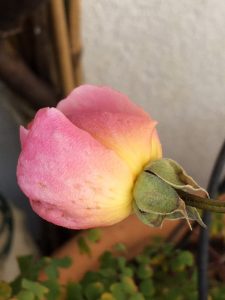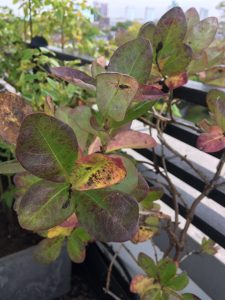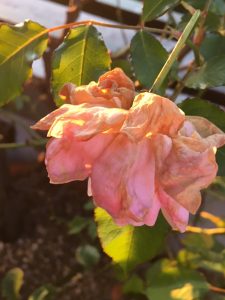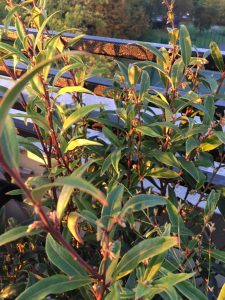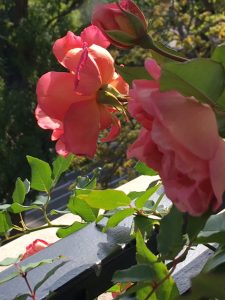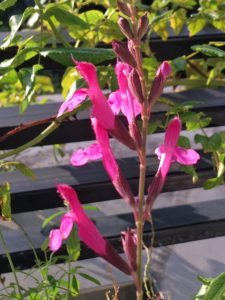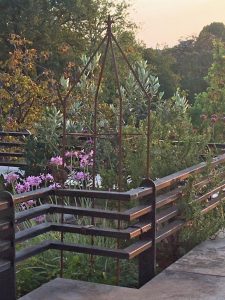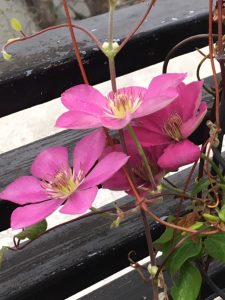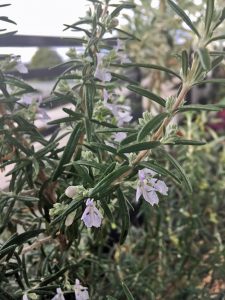Early Lessons
Perhaps I can learn some elementary Italian while teaching my Sardinian neighbours some basic horticultural principles – watering, feeding, right plant right place. The lessons have begun with my neighbours being introduced to ‘Spring bulbs’ the stalwart of Autumn planning and planting although I have yet to learn the Italian word for bulbs.
It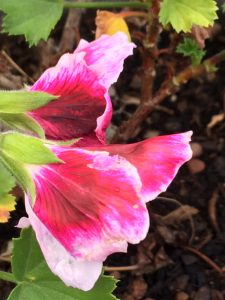 was mid-September, and high Summer had returned briefly to the roof garden when we had the first (informal) Level 1 introductory gardening tutorial. It came as a surprise to my tutees that on-going care was often required to ensure a spectacular display in due course, that finding plants to provide bright winter colour throughout an English Winter would be a challenge on a small balcony and that there were outgoings such as plant food and compost that would need to be funded and sourced.
was mid-September, and high Summer had returned briefly to the roof garden when we had the first (informal) Level 1 introductory gardening tutorial. It came as a surprise to my tutees that on-going care was often required to ensure a spectacular display in due course, that finding plants to provide bright winter colour throughout an English Winter would be a challenge on a small balcony and that there were outgoings such as plant food and compost that would need to be funded and sourced.
I later suggested adding some particularly cheerful red wallflowers to the shopping list.
At the same time, millions of acres of land were being destroyed by raging fires on the West Coast of America with mounting loss of life and livelihoods as vineyards shrivelled, smoke plumes rose and homes were lost. In Britain, after damaging floods earlier in the year the South West corner of England was battered by Atlantic storms during August, which exceptionally reached a sufficient magnitude to be named before moving north to Wales with devastating effect.
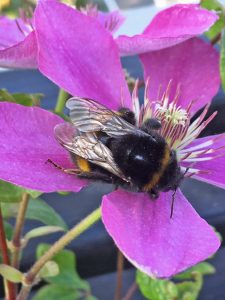 All hard to comprehend as the bees were still buzzing and the roses still blooming, flattered by the soft early morning sunlight and touched by a very gentle breeze. Hereabouts the idyll is interrupted not unusually by a noisy flock of parakeets unwilling to come too close to the building but making their presence felt perching on the dead horse chestnut opposite, while others prefer to squawk from further off. Sadly man’s hand has played a part in the tree’s demise, since after decades growing to full height, then lopped to ensure its twilight years, careless tarmacing by the property next door has brought this elderly, probably disease-ridden but majestic tree to its knees.
All hard to comprehend as the bees were still buzzing and the roses still blooming, flattered by the soft early morning sunlight and touched by a very gentle breeze. Hereabouts the idyll is interrupted not unusually by a noisy flock of parakeets unwilling to come too close to the building but making their presence felt perching on the dead horse chestnut opposite, while others prefer to squawk from further off. Sadly man’s hand has played a part in the tree’s demise, since after decades growing to full height, then lopped to ensure its twilight years, careless tarmacing by the property next door has brought this elderly, probably disease-ridden but majestic tree to its knees.
* * * * * *
It’s now mid-October and the horse-chestnut has gone, wider vistas have opened up and before I had a chance to establish an effective barricade of silver evergreens and other shrubs, the full force of Storm Alex hit. This is not without consequence as a vulnerable area, in an awkward spot (and last repaired in 2017 more or less coinciding with my first post on 3rd August that year) has resulted in water leaking into the flat below and once again we are left helpless in the face of Nature’s onslaught until drier weather and further repairs are completed.
Late Offerings
I’ve never made it to the East Coast of America in the Fall to coincide with the trees showing their wares, displaying spectacular vivid crimson and flame coloured leaves in Vermont, New Hampshire and elsewhere. If you time it right I believe you can follow the earliest changes in colour first in the colder north before travelling south as the seasonal display unfolds. All of which is tempting but may not reach the top of my ‘must see’ list as and when plans of this sort can be easily entertained again.
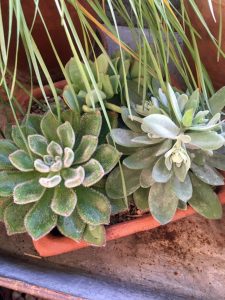 More immediately there are any number of spectacular displays closer to home, with gardens and hedgerows full of berries and leaves in Autumnal colours, which as they fall reveal half-hidden gems, like the magnificent cedar rising above the surrounding deciduous trees nearby no longer hidden by the craggy horse chestnut.
More immediately there are any number of spectacular displays closer to home, with gardens and hedgerows full of berries and leaves in Autumnal colours, which as they fall reveal half-hidden gems, like the magnificent cedar rising above the surrounding deciduous trees nearby no longer hidden by the craggy horse chestnut.
The combination of listening to the radio while preparing food often works well, and thus it was I happened upon the tail end of an interesting and comprehensive expositon of the processes by which leaves turn from green to yellow and red as the days shorten, and morning mists return. Key fluctuations in the weather, as well as the quality of the soil, play their part in this complex Autumnal rite with the emergence too of anthocyanin to add red colouration, and made afresh alongside the redistribution of nutrients associated with the breakdown of chlorophyll.
My attempts to introduce some Autumn colour, berries preferred, onto the roof garden have never met with much success. The nearest I managed was a rather neglected blueberry which did it’s best but as it wasn’t one of a pair didn’t fare well. Cotoneasters have been recommended and there are smaller varieties such as Cotoneaster naoujanensis ‘Buried Treasure’, which I have planted in the large containers which front the main entrance to the building, but its arching branches may take up too much space aloft, although I’m tempted to try and wonder why I haven’t done so before.
Hits and Near Misses
If you want to find make use of a roof-top space these would be my top tips, none of which are original, but which certainly hold true if you enjoy gardening, want to make use of an outdoor space however small and have a sunny situation. The same is probably true of a shady spot but plants choices would have to be rather different.
- Plant what you like rather than what you think would be a sensible choice for a particular situation. In a very small space you will treasure every plant and each will be very visible. But I’m beginning to think that my wonderful thulbaghias, which are the mainstay of the floral display from April to December, may have to be kept in check – they are alliums and the oniony aroma has rather dominated the space this Summer.
- Plant as many tall plants and small trees as space and weight considerations allow. As the taller plants form a framework, your roof garden will become a 3-D space. The thalictrum flowered for months this year, with the tallest over 8ft, and formed an informal hedge filling in some of the gaps between the bay and olives and taller roses and clematii. As they are herbaceous perennials th
 ey arrive as the days lengthen and vanish again as the days shorten, so ensuring that you don’t lose precious daylight in the Winter months, but they will take two or three years to reach their full potential. They are also surprisingly resilient even when grown in comparatively small containers. Unphazed by the Summer storms and happy to intermingle with other tall plants, including gaura and verbena bonariensis, they formed a fairly successful mutual support group this year, benefiting from their different growing habits.
ey arrive as the days lengthen and vanish again as the days shorten, so ensuring that you don’t lose precious daylight in the Winter months, but they will take two or three years to reach their full potential. They are also surprisingly resilient even when grown in comparatively small containers. Unphazed by the Summer storms and happy to intermingle with other tall plants, including gaura and verbena bonariensis, they formed a fairly successful mutual support group this year, benefiting from their different growing habits.
- If they are plants you like (see point 1) silver leaved trees and shrubs can combine permanent planting and continuity without cutting out too much light. I have four olives in various containers in different parts of the balcony and along pathways leading to the main, albeit miniature, terrace. They all get fed and watered quite regularly but not very systematically – three are producing olives, looking healthy and are very beautiful, the fourth has been in the ‘sick-bay’ all year and hasn’t really responded to my care and attention so I could/should use the container for something else. But I haven’t the heart to let my sickly olive go, partly I suspect as I think I overlooked it last year when we were again dealing with floods and roof repairs.
 If you are fortunate you will have wonderful neighbours who share their water supply, or perhaps pass on plants as they come and go. Four of my favourite silver leaved plants, including one of my treasured olives and a rosemary, were a departing gift and I’m hopeful that the same plants might be given temporary lodgings by the new occupants as and when the way has to be cleared for surveyors and builders.
If you are fortunate you will have wonderful neighbours who share their water supply, or perhaps pass on plants as they come and go. Four of my favourite silver leaved plants, including one of my treasured olives and a rosemary, were a departing gift and I’m hopeful that the same plants might be given temporary lodgings by the new occupants as and when the way has to be cleared for surveyors and builders. - It’s disappointing to plant something, whether on a whim, or carefully thought out, that turns out for one reason or another to be the wrong plant in the wrong place, but depending on your circumstances and inclination experiments can have surprising results and are well worth considering. Not so much an experiment, but arguably an unnecessary expense, have been garden or outdoor items that never quite did what it said on the tin: such as the beautiful and expensive heavy oak doorstop bought to keep open a door to nowhere except a small area for plants, that wasn’t tall enough, and is now acting as a prop for some other garden equipment. Or the narrow headed, long handled brush, specially designed to reach awkward corners of balconies and terraces, but which couldn’t be used at its full extent with the bristles at an effective angle.
But on the other hand who knew that self-seeded mallows will attract the bees well into Autumn, clematii and roses of all sorts are wonderfully happy aloft and if you are lucky enough to have a back-drop of tall trees and far reaching views you are well compensated for all the planting plans and garden projects that can never make it onto the drawing board, while of course missing the rustle of leaves underfoot and pining for space for a few more plants.
Nota bene – according to the Chambers dictionary –‘il bulbo’ is the Italian for bulb, or perhaps more correctly, ‘bulb’, the English word for any subterranean bud with swollen bases in which reserve materials are stored, is derived from L – bulbus or Gk – bolbos (onion). Meanwhile I have yet to have my first Italian lesson.
To Autumn
Season of mists and mellow fruitfulness,
Close bosom-friend of the maturing sun;
Conspiring with him how to load and bless
With fruit the vines that round the thatch-eves run;
To bend with apples the moss’d cottage-trees,
And fill all fruit with ripeness to the core;
To swell the gourd, and plump the hazel shells
With a sweet kernel; to set budding more,
And still more, later flowers for the bees,
Until they think warm days will never cease,
For summer has o’er-brimm’d their clammy cells.
Who hath not seen thee oft amid thy store?
Sometimes whoever seeks abroad may find
Thee sitting careless on a granary floor,
Thy hair soft-lifted by the winnowing wind;
Or on a half-reap’d furrow sound asleep,
Drowsed with the fume of poppies, while thy hook
Spares the next swath and all its twined flowers:
And sometimes like a gleaner thou dost keep
Steady thy laden head across a brook;
Or by a cider-press, with patient look,
Thou watchest the last oozings, hours by hours.
Where are the songs of Spring? Ay, where are they?
Think not of them, thou hast thy music too,–
While barred clouds bloom the soft-dying day,
And touch the stubble-plains with rosy hue;
Then in a wailful choir the small gnats mourn
Among the river sallows, borne aloft
Or sinking as the light wind lives or dies;
And full-grown lambs loud bleat from hilly bourn;
Hedge-crickets sing; and now with treble soft
The redbreast whistles from a garden-croft,
And gathering swallows twitter in the skies.
